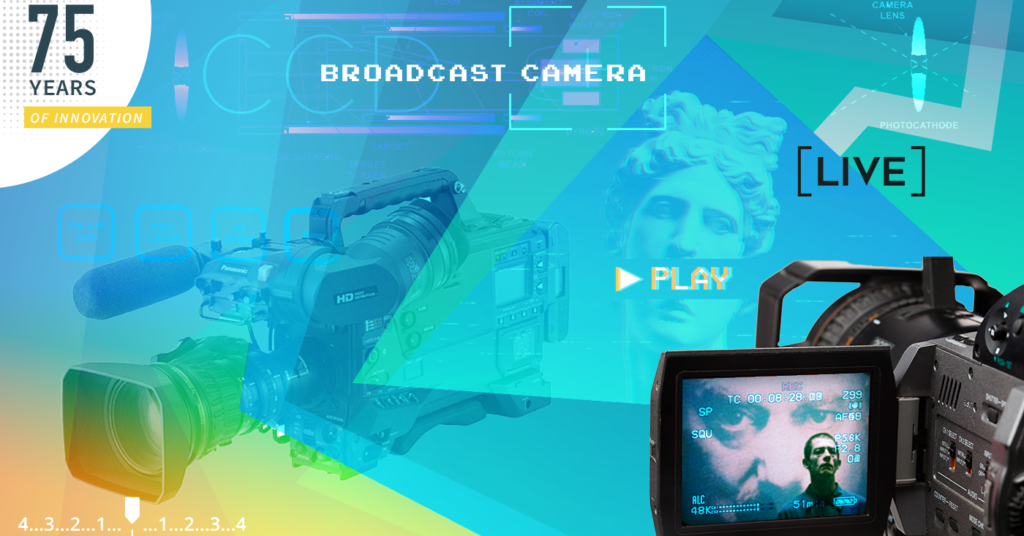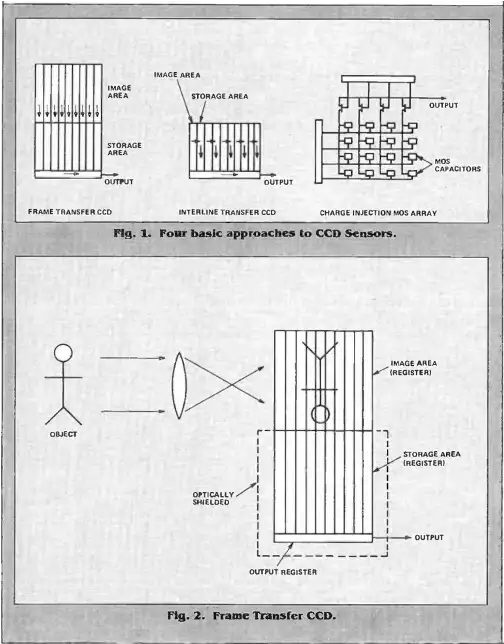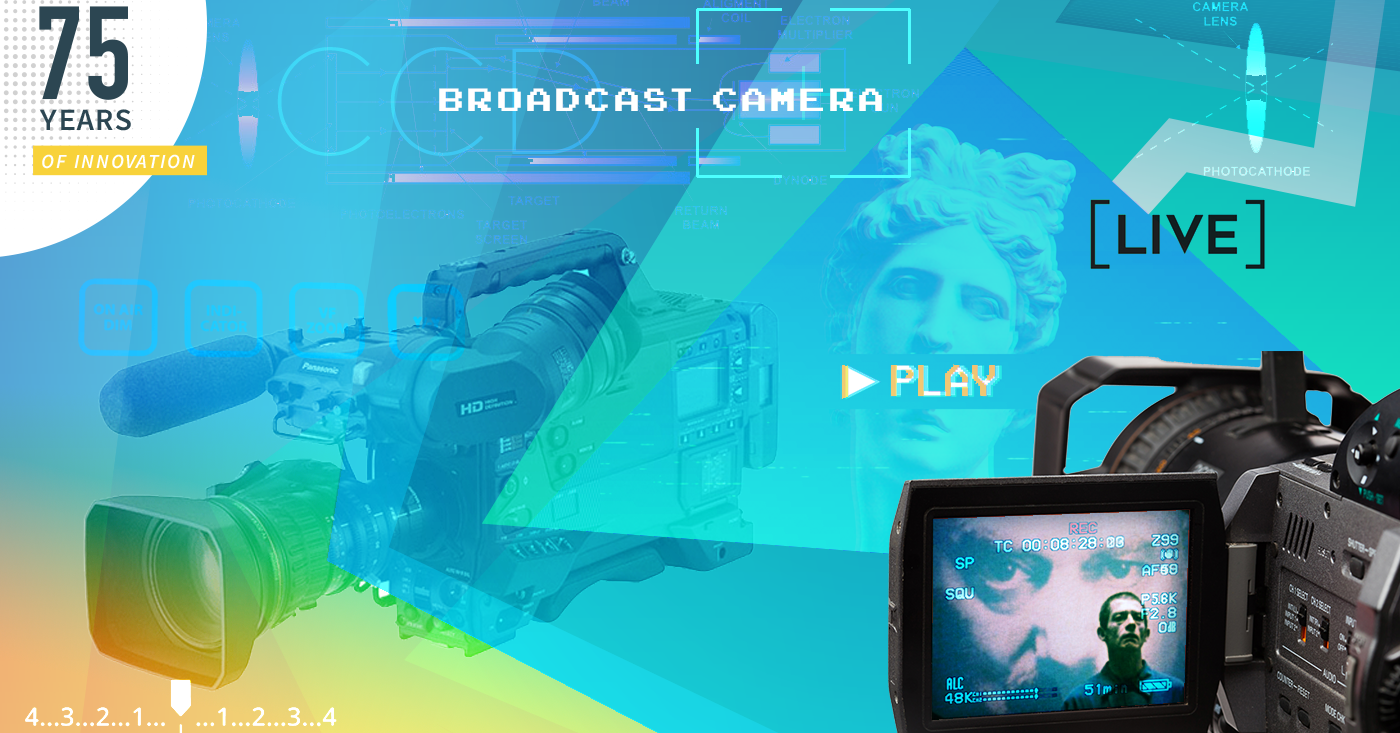Smile, you’re on a CCD camera
The 75 Years of Innovation series highlights the groundbreaking innovations spanning from SRI’s founding in 1946 to today. Each week, SRI will release an innovation, leading up to its 75th anniversary in November 2021.

“RCA’s solid-state CCD imager eliminates many of the most annoying deficiencies of photoconductive tubes” — RCA Broadcast News Volume 173, 1983
TV is incredibly popular. In 2019 in the U.S., an adult spent on average, 3 hours and 35 minutes per day watching television. Viewers of TV programs want crisp, sharp images; broadcasters need to be able to shoot from outdoors and inside, in real locations, not staged and controlled.
Broadcast cameras need to be versatile, light in weight, and robust. Cameras need to be able to capture great images in good light, in poor light, and under every condition imaginable.
Enter the solid-state CCD or Charge Coupled Device camera. This camera, invented by RCA’s David Sarnoff Research Center (now part of SRI International) was to change the life of the broadcast camera operator, for good.
How a Behemoth was Tamed by a Charged Couple
Back in the day, the people behind broadcast cameras had to be physically strong. Broadcast, aka, television cameras, were big beasts. Television cameras had to house a lot of large and heavy components; and, then there was the heat. The cathode-ray tubes of mid-twentieth century TV cameras became hot on use; this made working with several studio cameras uncomfortable. It was clear that the tube cameras of old had a limited lifetime.
Back in the 1960s, RCA’s David Sarnoff Research Center had developed the four-tube television camera, otherwise known as the “TK-42”. The camera was a new concept in color camera design, developed to improve picture quality and to tackle a number of the issues of broadcast cameras. The resulting picture was of high quality and crispness. The TK-42 also had extremely low heat dissipation and worked off a low power input of 750W, thereby making It easier to work with in small studio spaces.
However, even the TK-42 had its limitations.
In an appraisal by the UK’s British Broadcasting Company (BBC) in 1964, they described the four-tube television camera as having “disappointing” sensitivity and its color reproduction left “room for improvement”. Still, the BBC recommended its use back in 1964, after all, there was little choice back then.
RCA set about moving broadcast cameras into a next-generation of further improvements in sensitivity, clarity, portability, and usability. TV was becoming not just a popular, but a vital form of entertainment and communication. It was time to innovate. An even better way of making great TV was needed. Cameras that were versatile, lightweight, and robust were needed to boost TV into a new era.
Time passed; as is the will of technology, updates, innovations, and ‘tweaks’ are made to take the next steps in an approach. RCA continued to develop broadcast camera capability. They developed further modifications and eventually moved to a Charge Coupled Device. In 1983, RCA demonstrated its proprietary solid-state imagers at the NAB Convention (National Association of Broadcasters). The demonstration was given to an invited audience only, in a hotel across the road from the conference center itself. At this point, the camera was still experimental; however, the 1000+ people who managed to see the camera during the convention were astonished at the breakthrough it made in broadcast technology. It was the beginning of the kind of crisp and clear, all situation, television images, we are so used to in the 21st century.
How Does a Solid-State Charge Coupled Device (CCD) Work?
The RCA solid-state imager was based on a CCD. A solid-state Charge Coupled Device (CCD) is a photon detector that uses a silicon wafer, broken up into a large number of light sensitive areas, known as pixels. As light falls onto the pixels it is converted into electrons. How many electrons are generated is directly proportional to the light entering the area.

There are several methods that can be used to build CCDs. RCA chose to use the ‘Frame Transfer’ approach. The choice was made as the method offered high sensitivity with low output; it also removed any trailing smears, often seen with moving points of light. The result was clear, crisp, good-contrast, and smear-free images.
Frame Transfer CCD systems work by splitting the CCD, with an image area at the top and a storage area below. This allows for the transfer, line-by-line, of stored charge images to an output area. This storage area is protected from light sources. The images are focused on the image area at the top, the electron charges being then transferred to the storage area. This technique is called “Progressive Scan” readout.
The product brochure for the CCD-1, RCA’s first solid-state commercialized broadcast cameras states:
“The CCD-1 produces unbelievably great pictures, night or day, under all lighting conditions.”
Solid-state CCD was to be a game-changer for the broadcast industry. The cameras based on solid state CCD offered improved sensitivity, ability to work in poor lighting and better portability that the industry needed. Program producers could take broadcast into a new era where the sharper image ruled.
The Sharper Image
The CCD Camera started its life at RCA’s David Sarnoff Research Center and ended up in the stable of SRI International when RCA became the Sarnoff Corporation, a wholly-owned subsidiary. Since the development of solid-state CCD, cameras based on this technology have become the standard for the industry. In 1985, the company was given an Emmy® award for Outstanding Technical Achievement.
Resources
RCA Broadcast News Volume 173: https://www.americanradiohistory.com/ARCHIVE-RCA/RCA-Broadcast-News/RCA-173.pdf
Statistica, U.S. media usage — time spent watching television 2014–2021: https://www.statista.com/statistics/186833/average-television-use-per-person-in-the-us-since-2002/
BBC appraisal of the four tube color television camera, 1964: http://downloads.bbc.co.uk/rd/pubs/reports/1964-54.pdf
CCD-1 product brochure, TV Camera Museum Archives: https://www.tvcameramuseum.org/pdfs/rca/ccd-1catalog.pdf
American Radio History, TK-42 brochure: https://www.americanradiohistory.com/Archive-Catalogs/RCA/RCA-1966-Television-Cameras.pdf



